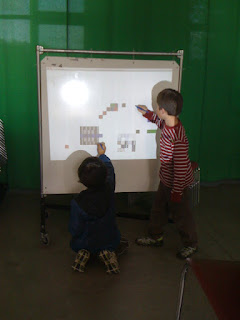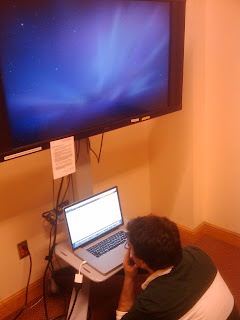CS 247 Design Iteration and User Testing Report
Team FLM
Throughout the quarter, the foundational crux of our design process was best described as a back and forth between designing while developing and user testing. We brainstormed as we built, and whenever we were at a loss for how best to decide between multiple pathways, we turned to user observation for both answers and guidance for the next round of development. What follows is an abbreviated overview of our experience this quarter.
As directed by the course syllabus, we set out to observe children at play at both the JLS and Nueva schools. Based on our findings, we realized a broad swath of features we wished to implement into our product--personalization, collaboration, narrative, and so forth. In truth, these ideas were quite basic; broad and unfocused, our intuited first design was a digital puppet stage manipulated via a projected whiteboard. Composed of avatars with the players' faces attached, the puppets would be malleable in a computer-generated environment, with possibly a variety of objects with which to be interacted, and even a few application-prompted objectives as well. In addition to controlling the placement of the puppet, players could also manually move the limbs of each avatar, encouraging cooperation. However, after a few weeks of prototyping, it was apparent that the project was rough in its presentation, and more challenging to fully realize aesthetically than originally intended.
Halfway through the quarter, we planned to engage in a series of observation trips back to Nueva, four in total. A single day before the first of those, one team member, perhaps inspired by the guest lecturer's demonstrations that day, came up with a new design idea. Still utilizing the projected whiteboard, the new project called for a digital wall of tiles, which could only be touched via IR pens. When swept across, the tiles spin individually, emitting music as feedback. In essence, the pens were conducting the board. There was no explicit goal or direction in this design. But as the next day's observation would reveal, this in fact was a cornerstone of strength for the device. In addition to these two ideas, we also demoed two physics-based toys and a goal-oriented treasure hunting game.
Between the two ideas (as well the other prototypes), the last-moment inspiration proved to be popular. Its immediate feedback required no upfront investment in figuring out how the application was used--its function was immediately observable and understandable. With no specific purpose, the children were free to interact with what we would coin the "wind wall" as they wished. Some players swept over the entire wall in streams, others preferred to pick at the wall in jabs. Some experimented with drawings or writings, others were more curious how many tiles they could spin simultaneously. However any degree of personalization of collaboration existed was entirely up to the cohesion of the players, for which up to four were supported.
Multiple instances of iteration and feature addition came afterward. A randomly moving tile--dubbed the "magic tile"--provided players with a target to chase after (if they wished). Catching the tile would result in an explosion of tiles spinning, eliciting a chorus of notes. A timer which counted down to the end of the game was also implemented, in order to facilitate the transition to allow waiting audiences a chance to play. We even integrated our face capture functionality from the original puppet design to display children's faces as the magic tile was caught. The timer, which ended in a game-over screen, was perhaps too successful in prompting children to leave the board, resulting in disappointment; what was witnessed to be more ideal was for the players who had become "experts" at the wind wall to introduce and explain the application to newcomers. The face capturing implementation proved to be too obtrusive in practice--the process of capturing faces via a camera required that the game be interrupted, ruining the constancy of the application. In our next round of observations, we determined that the first of these three ideas was the one most worth keeping. Not all of the children were piqued by the magic tile, only some were--and that might have been the point.
As we returned to our final bout of iteration, it became clear that the foundation of the wind wall's appeal was its simplicity, immediacy, and its freedom. Kids can make what they want of the wall, which in its starting state is but a blank white screen with a magic tile floating about. Exploration and experimentation was the key to the wind wall's success, as it allowed for each player to enjoy it as they liked--in this way, personalization, collaboration, narrative were features that were not instilled in the application, but grew out of the experience from use. In this vein of thought, we flirted with a few more visual ideas, but ultimately settled on leaving the aesthetics as clear-cut as they were. We interested ourselves instead with the still-unsolved need for directing players to allow others a go at the wall. In our observations, we found that this was less of a problem with girls, but that boys could be possessive--often using multiple pens per person--as well as obsessive--apparently oblivious to the existence of others behind them waiting to play. So instead of a game-over screen, we sought to implement a wave feature, which would periodically result in a vertical column sweeping across the board, distorting and thus "erasing" it. This would be accompanied by a physical fan placed to the side of the whiteboard, which would power on during the process.
Our final observation at Nueva came with mixed results. The fan effect pleased some children, who looked forward to the sensation and visual effect of the board being wiped. Others were confused by the event, unsure of what caused it, and were also perturbed that the effect seemed to obstruct them from whatever task they were at before. Finally, there were some children for whom the effect mattered little--they would continue playing with the board as they did before, even as the whole board was spinning. Some children who had tried out the application in the weeks prior seemed to infer that the implicit goal of the game was to turn as many tiles as possible. It was difficult to take away a uniform gain or loss from the fan implementation. To mitigate some of its perceived weaknesses, we hoped to smooth out the effect by adding visual and aural cues (e.g. a countdown, or a gust of wind) for when the board was about to receive its next waft.
Thus, we began with an ambitious and feature-rich idea, and by the end of the quarter, came to appreciate a simpler design instead. We found that because less time was spent getting the wind wall prototype into a functional beta stage (one afternoon!), we were much more free to insert and remove features as we pleased without much overhead. As already described, this undemanding design also allows users new to the platform to "figure out" the wind wall with minimal risk and effort. We have thus decided that the best thing that could happen come demonstration evening is that we would only have to spend ten seconds instructing the first batch of children "how" the wind wall is played. From there, we hope that those children would be able to pass on their knowledge to newcomers, and the cycle would feed upon itself for the remainder of the evening.






















































